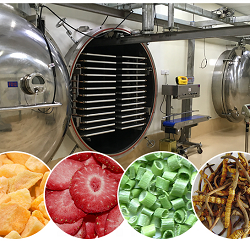Vacuum drying is that the mass transfer operation during which the moisture present in a substance, typically a wet solid, is removed by means of making a vacuum. In chemical process industries like food process, pharmacology, agriculture, and textiles, drying is an important unit operation to get rid of moisture. Vacuum drying is usually used for the drying of substances that are hygroscopic and heat sensitive, and relies on the principle of making a vacuum to decrease the chamber pressure below the pressure level of the water, causing it to boil. With the assistance of vacuum pumps, the pressure is reduced around the substance to be dried. This decreases the boiling point of water within that product and thereby will increase the speed of evaporation considerably. The vacuum drying method may be a batch operation performed at reduced pressures and lower relative humidity compared to close pressure, enabling quicker drying. The drying kinetics and drying efficiency of vacuum drying for fruits and vegetables is improved by combining microwave power to vacuum drying.
Vacuum Dryer:
Vacuum dryer is that the equipment with the assistance of which vacuum drying is carried out. in the pharmaceutical industry vacuum dryer is known by a standard name known as vacuum oven. Vacuum dryers are generally created from cast iron, however most currently are made from stainless steel, so they will bear the high vacuum pressure without any kind of deformation .The oven is split into hollow trays that will increase the extent for heat conductivity .The oven door is locked air tight and is connected to air pump to reduce the pressure.
The materials to be dried are kept on the trays within the vacuum dryer and pressure is reduced by means that of pump. The dryer door is tightly shut and steam is passed through the area between trays and jacket so the heat transfer happens by conductivity. Water vapours from the feed is distributed into the condenser and once drying pump is disconnected and therefore the dried product is collected from the trays.
Applications:
Vacuum dryer may be wont to dry heat sensitive hygroscopic and toxic materials. If the feed for drying is a solution, it may be dried utilizing vacuum dryer because the solvent are often recovered by condensation. to enhance quality of products, like for fruit preservation, hybrid drying combining osmotic dehydration followed by heat pump drying and microwave-vacuum drying proven effective.
drying is one amongst the foremost industrial drying techniques for heat-sensitive, hygroscopic, and/or toxic powders and granules. Avoiding excessive heat whereas drying powder is also necessary for a variety of reasons, starting from product quality to safety:
Pharmaceutical powders – active ingredients may lose their medicinal effect when warmed.
drying – certain nutrients may break down if exposed to high temperatures. Taste, consistency, and appearance can also degrade under too much heat.
Plastics and chemical processing – synthetic materials can leach toxins with prolonged exposure to heat. This can even make convection drying methods hazardous, as the hot air stream must eventually be emitted.
Vacuum drying may be a safe and extremely methodical technique for drying giant volumes of heat-sensitive powders or granules at a far lower temperature than would be needed in a traditional industrial dryer. In a vacuum, wherever ambient pressure is reduced, the flashpoint of liquids lowers significantly.
Drying is among the foremost energy-intensive unit operations, because of the high latent heat of vaporization of water and therefore the inherent inefficiency of using hot air because the (most common) drying medium. Depending on the precise product attributes needed, completely different business sectors need different types of drying technology. Drying high-value products that are seemingly to be heat-sensitive, like food, pharmaceuticals and biological products, demands special attention. Once dried by convection at higher temperatures, these heat-sensitive products.
We at KERONE have a team of experts to help you with your need for vacuum drying in various products range from our wide experience.

